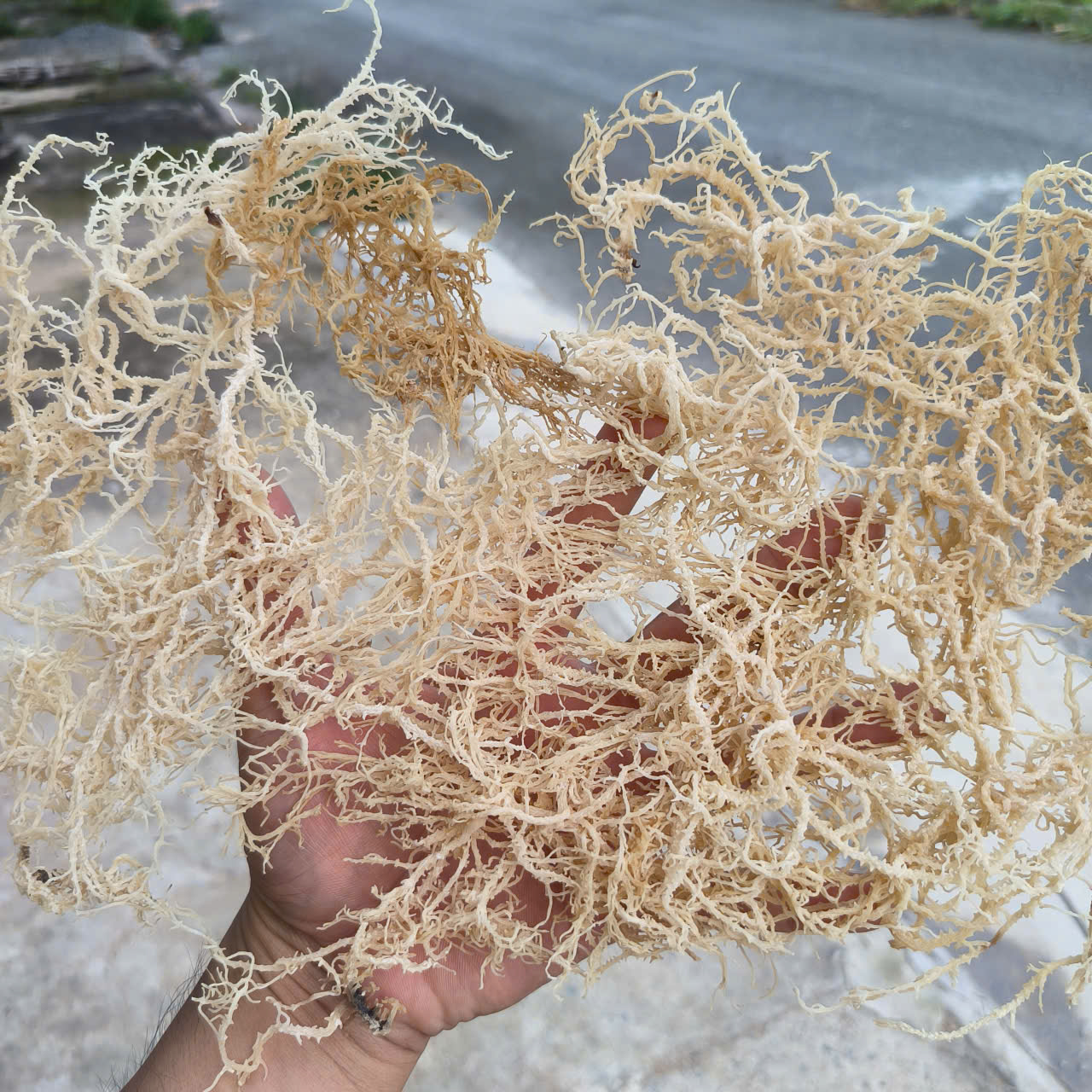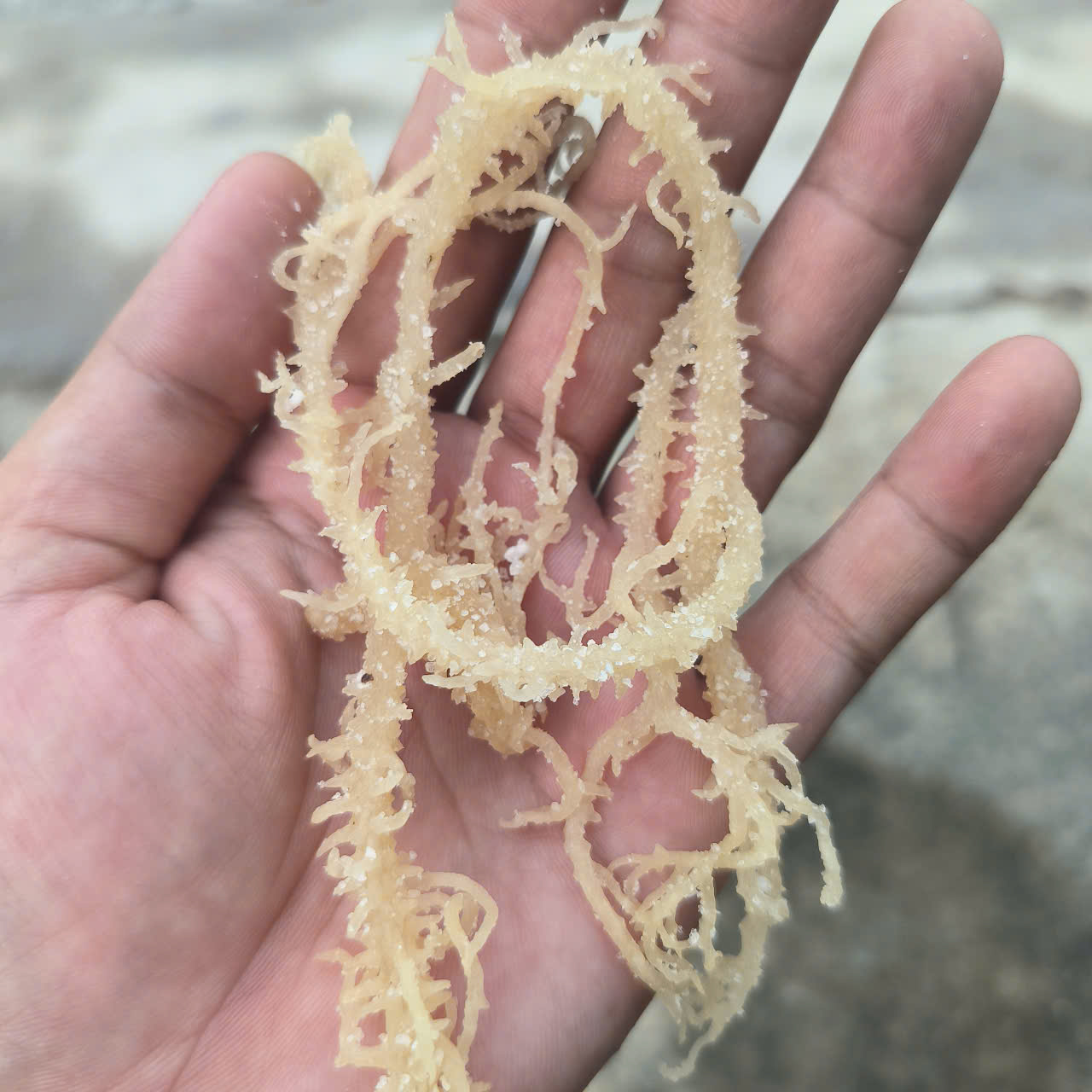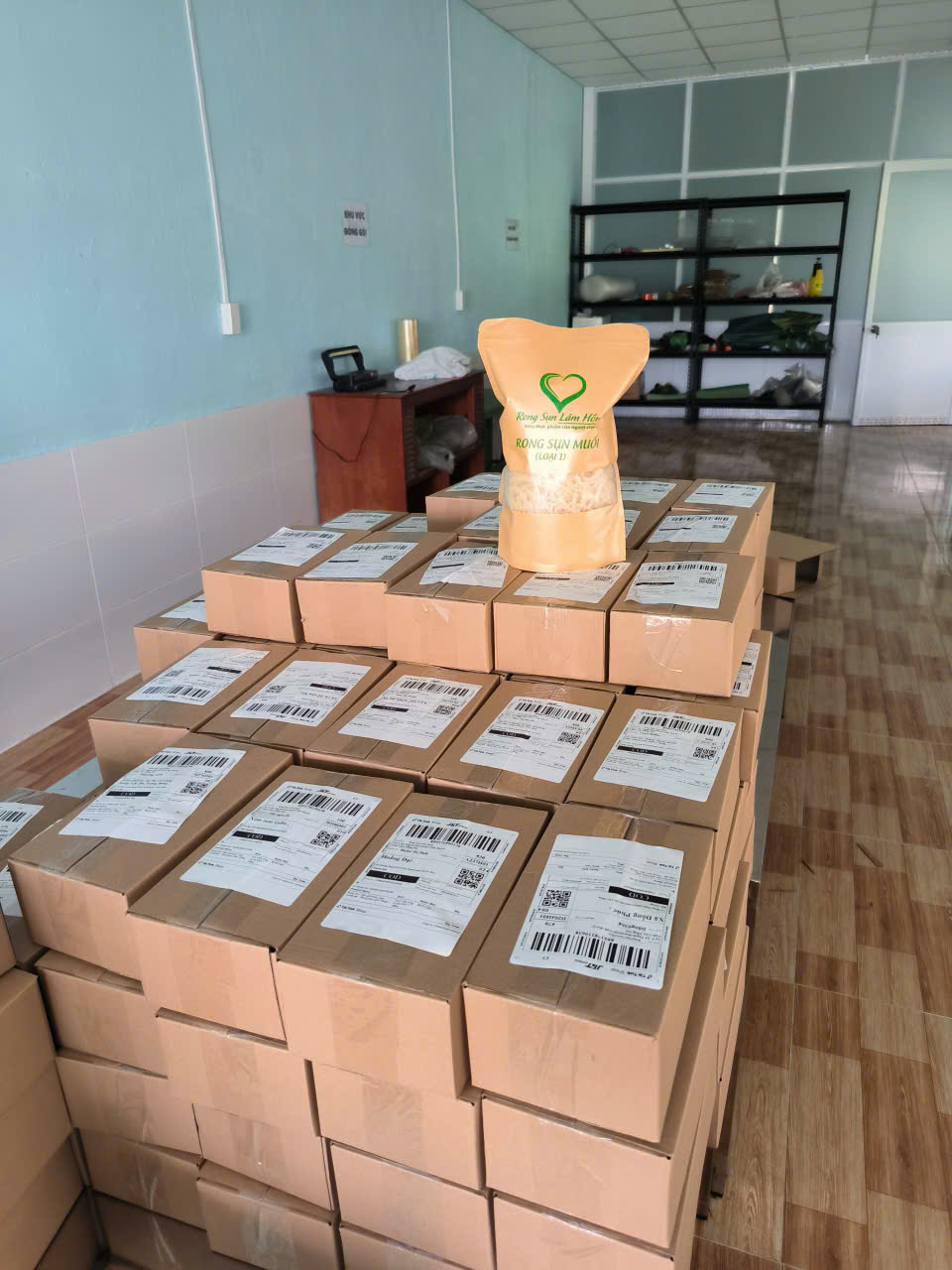The debate between wild vs organic cultivated Eucheuma spinosum is becoming increasingly relevant for businesses seeking reliable raw materials for production. In modern supply chains, ingredient selection is no longer just about pricing, it is now closely tied to sustainability philosophy, international compliance, and brand positioning strategy.
In the seaweed industry, particularly for Eucheuma spinosum, a species widely used in functional foods, pharmaceuticals, and cosmetics, two types of raw materials are under consideration: wild vs organic cultivated Eucheuma spinosum.
So, what exactly distinguishes these two product categories? And more importantly, which direction should businesses take to ensure optimal product quality and market access potential?
For further consultation and sourcing options, feel free to contact Lam Hong, a trusted supplier of organic sea moss traceability and testing solutions.
1. Differences in origin and production process
In the context of sustainable sourcing and international supply chains, understanding the origin and farming method of seaweed plays a critical role in ensuring consistency and compliance. The comparison between wild-harvested Eucheuma spinosum and organic cultivated Eucheuma spinosum reveals fundamental differences in approach, quality, and traceability.

Lam Hong Sea Moss's Eucheuma Spinosum product qualifies for Organic certification
1.1. Wild-harvested Eucheuma spinosum
This type of seaweed is collected directly from the open ocean, typically in untouched marine environments such as natural reefs or remote coastal areas. It grows seasonally without human intervention or agricultural control, resulting in variable quality and supply.
1.2. Organic cultivated Eucheuma spinosum
In contrast, this variety is grown in clean, regulated marine zones through certified organic seaweed farming practices. The farming process is controlled end-to-end, from seed selection and planting density to harvesting time, drying methods, and final packaging, ensuring consistency and safety across batches.
Key distinction:
While wild-harvested Eucheuma spinosum reflects a natural, traditional harvesting method, it lacks uniformity and scalability. Organic cultivated Eucheuma spinosum, on the other hand, offers consistent quality, higher food safety, and traceability, making it ideal for global B2B supply chains.

Images of Lam Hong’s organic sea moss products
Comparison table: Wild vs organic cultivated Eucheuma spinosum
|
Criteria |
Wild-harvested Eucheuma spinosum |
Organic cultivated Eucheuma spinosum |
|
Origin |
Naturally sourced from the ocean; harvested manually without regulation |
Grown in clean marine zones with zoning and production control |
|
Production process |
Unregulated, seasonally dependent |
Follows certified organic seaweed farming protocols |
|
Product consistency |
Inconsistent across batches |
High consistency through controlled farming conditions |
|
Traceability |
Nearly absent |
Full traceability down to farming location and lot number |
|
International certification |
Rarely compliant |
Eligible for EU Organic, USDA Organic, JAS, and more |
|
Best use cases |
Small-scale, local, or artisanal production |
Premium, export-grade products for global markets |
2. Differences in purity and product safety
In evaluating wild vs organic cultivated Eucheuma spinosum, purity and safety standards are critical considerations - especially for industries such as pharmaceuticals, cosmetics, and functional food manufacturing.
2.1. Wild-harvested seaweed benefits
In some remote, deep-sea environments, wild-harvested seaweed may naturally contain high mineral content due to its exposure to unpolluted waters. However, the purity of wild-harvested Eucheuma spinosum is not guaranteed and heavily depends on the local ecosystem. If harvested in areas affected by industrial or agricultural runoff, the seaweed is susceptible to contamination with heavy metals, microbes, and other organic residues.
2.2. Certified organic seaweed farming
In contrast, seaweed grown under certified organic seaweed farming systems undergoes rigorous quality control. Each batch is tested through a Certificate of Analysis (COA), verifying moisture content, microbial safety, and heavy metal levels. Additionally, these farms prohibit the use of chemical fertilizers or preservatives, ensuring a clean-label and eco-conscious product.
Core difference:
Wild-harvested seaweed may offer purity under ideal environmental conditions, but results vary widely. Organic cultivated seaweed consistently delivers safe, reliable, and internationally compliant quality due to strict farming and testing protocols.

Packing area at Lam Hong Sea Moss facility
Composition and purity comparison
|
Component/metric |
Wild-harvested Eucheuma spinosum |
Organic cultivated Eucheuma spinosum |
|
Carrageenan content (%) |
25–30% (varies by harvest location) |
28–35% (higher due to controlled farming) |
|
Post-processing moisture |
15–20% (inconsistent across batches) |
12–15% (consistent via cold-drying methods) |
|
Heavy metals (pb, hg) |
Higher risk in polluted areas |
Within global COA safety limits |
|
Organic impurities (shells, sand) |
Often present, difficult to remove completely |
Minimized through regulated cleaning, drying, and sieving |
|
Harmful microorganisms |
Potential risk, especially with uncontrolled sun-drying |
Routinely tested under HACCP standards |
|
Sea salt content |
Often elevated, may require extra treatment |
Adjustable through post-harvest processing |
This comparative analysis highlights a key aspect of the broader seaweed sustainability comparison: while wild-harvested seaweed may carry natural appeal, certified organic seaweed farming ensures scalable, traceable, and clean input materials for high-standard markets.
3. Hidden risks when Eucheuma spinosum cannot be traced
In the export of food and raw materials, particularly for premium markets served by organic sea moss, the inability to ensure traceability is not merely a technical oversight; it represents a systemic risk with serious legal, financial, and reputational consequences.
Below are the key risks that businesses may face if they source Eucheuma spinosum without proper traceability codes or verifiable lab documentation:
3.1. Risk of shipment rejection and market loss
Markets such as the United States, EU, Japan, and South Korea require strict documentation for traceability as part of their import protocols.
Failure to provide essential records, such as COAs (Certificates of Analysis), phytosanitary certificates, or seaweed farming origin details, may result in:
- Denied customs clearance
- Goods returned to origin
- Inclusion on import “watchlists”
Impact: Increased logistics costs, delayed orders, contract penalties, and long-term market exclusion.

Products after packaging are waiting to be shipped from Lam Hong Sea Moss's facility.
3.2. Legal and regulatory compliance risks
If a shipment is found to contain heavy metal residues, microbial contamination, or mislabeling as “organic,” businesses may face:
- Fines or administrative sanctions
- Bans from importing into key markets
- Lawsuits from international B2B partners
Consequence: Breach of contract obligations and loss of legal status in high-value markets.
3.3. Brand reputation and consumer trust risk
Today’s consumers are increasingly focused not just on quality, but on transparency and ethical sourcing. So they will ask questions such as:
- Is the origin of the ingredient verifiable?
- Does the brand adhere to environmental and social responsibility standards?
Using non-traceable or uncertified Eucheuma spinosum can:
- Undermine customer trust
- Damage brand image in marketing and public relations campaigns
Impact: Difficulty scaling sustainably, loss of access to global retail systems like Whole Foods, Amazon Organic, or European organic spa chains.
3.4. Risk of failing supply chain audits
Global corporations increasingly require ESG audits and backward traceability as part of supply chain integrity.
If your seaweed inputs lack transparency, it will be difficult to:
- Qualify for long-term export contracts
- Secure exclusive distribution agreements
- Expand OEM/ODM partnerships
Result: Lost opportunities to become a strategic supplier for leading global brands.
This reinforces a key aspect of the seaweed sustainability comparison within the broader wild vs organic cultivated Eucheuma spinosum debate: while wild-harvested seaweed may offer initial cost advantages, the long-term security, transparency, and scalability of certified organic supply chains are far superior.
Solution: integrate traceability and testing from the start
To mitigate the risks outlined above, businesses should source from certified organic seaweed farming operations, those offering Organic Cultivated Eucheuma spinosum with full traceability codes, international COAs (Certificates of Analysis), and third-party lab verification.
This is more than just a “trade passport” into high-tier export markets, it is a long-term ethical commitment to quality, transparency, and sustainable growth, core to any forward-looking business strategy.
4. Branding & market strategy: A key difference
In the discussion of wild vs organic cultivated Eucheuma spinosum, product origin also impacts your brand’s market positioning.
Wild-harvested Eucheuma spinosum is ideal for boutique or artisanal brands that value "untouched nature" as a core identity and operate on a small scale.
Organic cultivated Eucheuma spinosum is better suited for companies aiming to:
- Build a green and transparent brand image
- Join global retail ecosystems such as Whole Foods, Amazon Organic, and European organic spas
- Align with sustainable growth strategies and international ESG benchmarks
This makes the seaweed sustainability comparison not just a question of farming method, but also a strategic choice in global brand positioning.
5. Which type should your business choose?
Both types of Eucheuma spinosum offer distinct value depending on your business model:
- For consistent quality, scalability, compliance, and B2B readiness, choose certified Organic Cultivated Eucheuma spinosum.
- For unique wild origin storytelling and localized control, wild-harvested remains an option—if backed by reliable safety and traceability processes.
Contact Lam Hong to secure high-quality seaweed products at cost-effective pricing aligned with your business scale.






